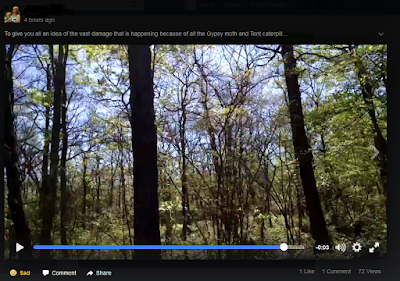Karla Salp
Outreach Coordinator
It’s not every day that my job lets me leave the office, trek to the top of a mountain overlooking the San Jua
n Islands and do a live Twitter cast.
Even better, I spent the day with Kathleen Patton, a WSDA trapper who exemplifies the fine work trappers are doing around the state to search for gypsy moth and also happens to be a kick in the pants.
 |
| Trap overlooking the San Juan Islands |
A trapper with WSDA for 10 years, Kathleen has the unique challenge of trapping on Washington’s islands. I tagged along to see what gypsy moth trapping is like…island style.
One of the challenges of island trapping became apparent immediately: the ferry. I had to hop the 6 a.m. ferry from Anacortes and ride more than an hour before we reached Orcas Island. After disembarking, Kathleen and I made our way to the east side of Orcas Island, where we would be trapping for the day.
Having trapped the island for several years, Kathleen already knew where she would place many of the traps – down to the tree – even without the map that WSDA provided. She quickly went from one trapping location to another, rarely needing to consult her map.
Trapping Technology
 |
| Kathleen logs a trap location using her iPhone |
Technology has changed trapping, Kathleen said. At one time, trappers marked maps by hand, but those days are long gone. Now, as soon as she sets a trap, Kathleen gets on her iPhone and logs the location by GPS. This is automatically uploaded into a statewide mapping system that gypsy moth program staff can review to see where the traps are and the last time the trap was checked.
 |
| Kathleen hanging a trap on the back of a tree |
But some things never change, such as Kathleen’s thoughtfulness in placing the traps. At one stop, a trap was needed on an old, beautiful tree. Kathleen made sure to put the trap on the back of the tree so the trap would not show up in photographs people would take of the tree.
At the top of Mt. Constitution, Kathleen agreed to do a live video broadcast on our Twitter account about gypsy moth trapping on the islands. Wandering around to find at least a few bars of reception on my cell phone, we settled on a beautiful spot overlooking the water. Kathleen was a natural and may have a future in broadcasting, as she did an excellent job explaining gypsy moth trapping, even responding to questions that viewers asked on the fly.
Click here to watch the recorded broadcast.
 |
| Mt. Baker from the ferry |
As we continued along, setting about 40 traps that day, Kathleen’s passion for the islands and her dedication to protecting them from invasive species like the gypsy moth was evident. She told me all about the island and island life as we wound through steep and unpaved roads that she knew well, even pointing out a plant that had become a problem on part of the island.
Before long, trapping for the day was over. Kathleen had to catch the 3 p.m. ferry back - the next one stopping at her island would not get her home until 7 p.m. One thing I definitely learned was that when trapping on the islands, you live by the ferry schedule.



























